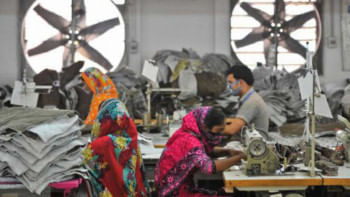Discussing climate adaptation finance at NAP Expo 2024

The NAP Expo 2024, organised by the Least Developed Countries Expert Group (LEG) under the UN Framework Convention on Climate Change (UNFCCC), is being hosted in Dhaka from April 22-25. Its objective is to share experiences and foster partnerships among stakeholders on how to expedite the implementation of National Adaptation Plans (NAPs), to achieve "transformative adaptation." This concept is being used increasingly by development agencies, as mere incremental steps will not suffice against climate extremes which impact the LDCs most. But this requires a key provision as an enabler: adequate international adaptation support, particularly for the LDCs.
However, what is the current status of adaptation finance? The first fact that pops out is that more than 60 percent of adaptation finance delivered to LDCs comes as loans, not grants, which fuels their already acute debt distress. Beyond that, more than half of the support to LDCs is meant to finance mitigation efforts, where adaptation is the primary and urgent need. Moreover, a lion's share of foreign aid packaged as climate finance is increasingly benefitting middle-income countries, at grave loss to the LDCs/LICs. Looking ahead, no road map was provided at COP28 for doubling adaptation finance, as was decided at COP26. Finally, the apprehension of cannibalising the little adaptation and other disaster risk reduction (DRR) funds of the UN and World Bank systems by the new Loss and Damage Fund is evidenced by mobilisation of less than $200 million for adaptation at COP28, against the target of just $300 million.
The narrowing fiscal space is already evident in very poor climate finance commitments by the US, followed by the recent curtailing of aid budget by some major EU countries. Coincidentally, 2024 is an election year in over 50 countries, but at least 20 of them, with competitive elections, will address climate change as a contested issue. The likely political shifts after these elections this year will have lasting ramifications for climate diplomacy. There are indications already that green parties in Europe will not fare well, and if Trump wins, the already poor US support is likely to dwindle further.
Against these odds, some positive trends present themselves as thin silver linings. We may recall that, together with the Bridgetown Initiative, last year's meetings on finance in Paris and Nairobi made the case for debt relief, enhanced international taxation for leveraging new sources of finance, and financial architecture reforms. The multilateral development banks pledged an additional $300-$400 billion to low-income countries over the next decade. Another reform agreed upon is a change to the World Bank's debt-to-equity ratio by one percent, to 19 percent, which may free up around $4 billion a year. The UNFCCC executive secretary recently called for the International Monetary Fund (IMF) to make more use of an obscure fund called the Catastrophe Containment Relief Trust, which provides grants for debt relief to the poorest countries when disasters hit a preset threshold of destruction. But the latest IMF report showed that the fund is in poor financial state.
So, adequate climate finance can in no way be mobilised without some extra budgetary sources. Brazil, as chair of the G20, is working to agree on a little tax on billionaires, and some of this levy could support climate action.
Another new instrument being agreed on by governments at the International Maritime Organization is to put a price on shipping emissions. But shipping negotiators suggest that this money is used to clean up their industry, and not as climate finance. Another research being completed by this author and his team is about a revised International Air Passenger Adaptation Solidarity Levy, which may mobilise up to $50 billion a year to finance adaptation.
We may recall that the cardinal principle of climate regime—the common but differentiated responsibilities based on respective capabilities—implicitly refers to polluter pays principle (PPP), which developed countries do not agree for international application, but apply in different ways within their borders. The Western market-based model upon which climate regime is founded taught us that climate change was the biggest market failure, which can be corrected through application of the PPP. While solid waste dumping is increasingly costly, emissions straddle across borders, as if atmospheric dump is free. Such moral corruption may not last long, as an increasing number of court cases are pending the world over, seeking monetary damages from big emitter governments and fossil fuel companies.
We may also recall the climate talks in Dubai where 159 world leaders committed themselves to action on food security and climate change by signing the Emirati Declaration on Sustainable Agriculture, Resilient Food Systems, and Climate Action—the first of its kind. This commitment needs to align with other plans for scaling finance. Such recalibration of institutions' balance sheets for leveraging adaptation finance is a welcome development.
The NAP Expo 2024 will be an opportunity for many good adaptation practices to be shared across the Global South. Bangladesh, as the host, has many lessons to share—its model of disaster management and its smart agriculture and adaptation practices among them. These lessons can be strengthened with two additional steps: scaling locally led adaptation as stipulated in the Mujib Climate Prosperity Plan and developing the Monitoring, Evaluation and Learning Framework, as suggested by the COP28 decision under the Global Goal on Adaptation. But these achievements in Bangladesh, mostly at the cost of domestic resources, cannot be sustained for long in view of the country's increasing burden of debt repayment. So, there is no alternative for LDCs/LICs to scale grant-based adaptation finance, to be mobilised by imposing solidarity levies on emissions.
Mizan R Khan is independent consultant and technical lead at the LDC Universities' Consortium on Climate Change (LUCCC).
Views expressed in this article are the author's own.
Follow The Daily Star Opinion on Facebook for the latest opinions, commentaries and analyses by experts and professionals. To contribute your article or letter to The Daily Star Opinion, see our guidelines for submission.


 For all latest news, follow The Daily Star's Google News channel.
For all latest news, follow The Daily Star's Google News channel. 










Comments